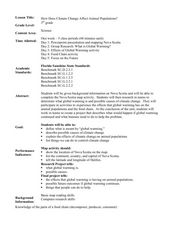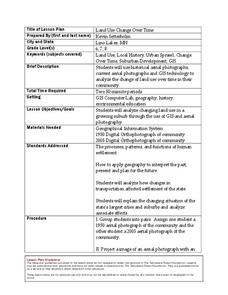Curated OER
State Change
Eighth graders explore the physical change of matter. As a class, they discuss their favorite super hero and determine if the hero undergoes a physical or chemical change. Students examine the change of state and phase change. In groups,...
Curated OER
Changing Matter
Fifth graders conduct an experiment. In this changing matter lesson plan, 5th graders receive a cup of crystals, record their observations, add water to the crystals and record new observations. Students then discuss the differences...
Curated OER
Globe Lesson 15 - The Changing Seasons - Grade 6+
In this changing seasons activity, students read about the geography concept of changing seasons and then respond to 9 short answer questions.
Curated OER
Chemical and Physical Changes
Young scholars experiment, identify and apply the concepts of chemical and physical changes utilizing real-world examples. They discuss and model physical and chemical changes, answer guided questions and play a game that reinforces the...
Association for Library Service to Children
Summer Reading List Grades 6-8
What better activity is there for summer than reading? Provide your pupils with 25 book ideas for their summer reading pursuits. A variety of different genres are represented on this list, and each book is paired with publication...
Curated OER
How Does Climate Change Affect Animal Populations?
Students investigate the effect of climate change on animal population in Nova Scotia. In this environmental science lesson, students complete a Nova Scotia map activity and research the causes of global warming in small groups. Students...
Curated OER
Land Use Change Over Time
Learners use historical aerial photographs and current aerial photographs to compare the change over time to the land. For this land changing lesson plan, students analyze, compare, contrast, and list the land change in their own community.
Curated OER
Changes in Nature
Fifth graders identify the chemical and physical changes in the water cycle, carbon cycle, and the effects of weathering. They analyze the periodic table, and observe how vinegar reacts with limestone in a chemical reaction that causes...
Curated OER
Climate Change
Students discuss global warming. In this global warming lesson, students read an article about global warming and list five things they learned. Students work in small groups to compare what they wrote. Students illustrate one of the...
Curated OER
Spelling Connections Grade 2: Rhyming Words
For this spelling worksheet, students analyze six pictures and the words printed above them with a circled letter. Students change the circled letter in the word to make a rhyming word that fits each picture. Students then use a code...
Curated OER
Physical and Chemical Changes in Matter
Students investigate chemical and physical changes. In this chemical and physical changes lesson plan, students distinguish between a chemical and physical change when observing baking bread and hot dogs and bagels cooking on a grill....
Curated OER
Discovering Chemical Changes
Fourth graders predict what happens in a teacher demonstration of a chemical change, before watching it. They observe the demonstration and list what the see on the board before determining which represent chemical change. Working at...
Curated OER
Experimenting with Physical Changes
Fourth graders explore physical changes. They discuss that physical change is a change in size, shape, or state of matter of a substance. Students explore what change takes place when two substances can dissolve each other. They observe...
Curated OER
Time For Change
Students examine and discuss the inventions and changes created by the Industrial Revolution. They create posters or clay models about inventions, write paragraphs about the advantages and disadvantages of the changes, and develop a...
Curated OER
The Changing Experience of Colonial Childhood
Students research how childhood was depicted in art in the 17th through 19th centuries. In groups, they research pieces of art and write a paper explaining how the portrayal of students in art changed at the end of the 18th century.
Core Knowledge Foundation
A Time for All Seasons - Fall
The weather is cooling down and the leaves are starting to change color; fall is right around the corner. Celebrate this special time of year with this earth and life science lesson series that teaches children about the causes of...
Core Knowledge Foundation
A Time for All Seasons - Spring
Celebrate the arrival of spring with this fun primary grade science unit. Engaging young scientists with a variety of hands-on activities and inquiry-based investigations, these lessons are a great way to teach children about seasonal...
Core Knowledge Foundation
A Time for All Seasons - Summer
The sun is shining and the birds are singing, what better time to teach young learners about the fun season of summer. In this week-long science series, children learn how the rotation and orbit of the earth influence the days and...
Safe Routes to School
Pollution & Evolution
Bring together a study of two major scientific topics with a lesson on the relationship between pollution and evolution. With the help of a PowerPoint presentation, hands-on activity. and class demonstration young scientists learn how...
NOAA
Where Have All the Glaciers Gone?
What happens when ice melts? Well ... water happens. When that melting ice is a glacier, the amount of water that results produces change throughout the world. Middle school science sleuths uncover the truth about global warming, the...
Chicago Botanic Garden
Historical Climate Cycles
Ice core samples give scientists access to climates of old—those from more than 800,000 years ago. Through an analysis of various temperature graphs from ice cores, tree rings, and weather stations, scholars compare historical climates...
Chicago Botanic Garden
Unit 4 Pre-Assessment
Pre-assessments are great to help teachers determine what information their classes lack, what misconceptions they have, and how in depth to teach specific concepts. The first in a five-part series is a pre-assessment of middle...
Chicago Botanic Garden
Seasons of a Plant
The third in a series of six lessons is an engaging three-part activity defines that discusses phenology, focusing on the cyclic seasons of plants. Pupils then observe phenology outside before determining how climate change can...
STEM for Teachers
Temperature and Bounce
Take part in a fun experiment and hold an impromptu bouncing contest with your class. Young scientists heat and cool balls before bouncing them to determine whether temperature changes affect how they bounce. The set of STEM lesson plans...

























